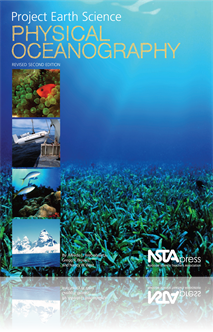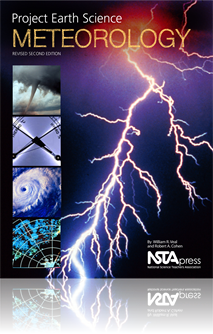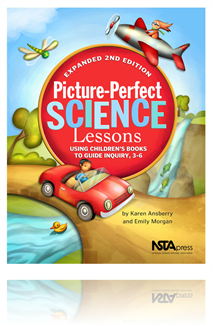All Book Chapters
Book Chapter
A wave is a disturbance that transmits energy from one location to another. In the ocean, most waves are created by the action of the wind over the surface. The interaction of the waves with the bottom near the shore causes the waves to break. Larger...
Book Chapter
Water is often called the universal solvent because so many substances will dissolve in it. Why do so many substances dissolve readily in water? In this Activity, you will explore the solubility of various substances in water as compared with other l...
Book Chapter
The ocean plays a fundamental role in many ways: from affecting the global climate and its variability, to phenomena such as El Niño, to the dispersal of pollutants such as oil spills. Understanding the dynamics controlling the ocean is essential to...
Book Chapter
If you have ever gone swimming in an ocean, or better yet, in Great Salt Lake, Utah, you may have noticed that it was easier to float in the ocean or in Great Salt Lake than in a pool or freshwater lake. Why is this? In the first part of this Activit...
Book Chapter
Ocean water is not the same everywhere. In some places, the water is colder or deeper than in other places. Some parts are denser or contain differing amounts of dissolved salts than other parts. All these things affect the way ocean water behaves. ...
Book Chapter
The Myth of Davy Jones’s Locker
For centuries, sailors believed that bodies buried or lost at sea did not sink to the bottom. They believed that a special depth existed between the surface and the bottom of the ocean where a body would remain suspended. Sailors called this region o...
Book Chapter
Estuaries — Where the Rivers Meet the Sea
An estuary is a body of water partially enclosed by land that has a connection to a river or stream, and an opening to the ocean. They are places where freshwater coming from rivers and streams mixes with salty ocean water. In this Activity, you will...
Book Chapter
Recycled Water: The Hydrologic Cycle
If we cannot see the water vapor, how do we know water vapor exists? In this Activity, you will examine the evidence regarding the presence of water vapor in the air and explore how water vapor plays a key role in the formation of clouds and rain....
Book Chapter
Lightning is not only visually spectacular; it is also dangerous. Lightning is one of the leading causes of weather-related deaths and injuries in the United States each year, not to mention damage to property. Knowing the properties of lightning,...
Book Chapter
In this Activity, students write an original, creative story about the movement of a water molecule through the hydrologic cycle....
Book Chapter
Measurement scales are standard values that can be used to compare properties. In meteorology, several scales may be used for the same quantity, depending on the purpose. For example, in the United States, temperature is frequently measured in ter...
Book Chapter
Have you ever looked up in the sky and seen a cloud in the shape of an animal? Regardless of the shape or size, certain conditions need to be present for a cloud to form. In this Activity, you will explore the conditions that must be present for clou...
Book Chapter
If you watch the local news, you have probably heard meteorologists talk about the humidity as well as the temperature. In this Activity, you will use the fact that the amount of water vapor at saturation depends on the temperature to determine how h...
Book Chapter
Snowflakes are made of ice. We think of ice as being frozen water. However, if you have ever seen a snowflake, chances are you have noticed that snowflakes do not look like most examples of frozen water we are used to seeing (e.g., ice cubes, icicles...
Book Chapter
Have you ever heard the word “muggy” used to describe the weather? How about the phrase “hazy, hot, and humid”? These phrases are used to describe times when there is considerable moisture in the air. In this Activity, you will measure humidi...
Book Chapter
The air inside a cloud can be very different from the air outside the cloud, not only because of the presence of cloud droplets and increased water vapor, but also in terms of density and temperature. In this Activity, students learn what types of cl...
Book Chapter
Meteorologists collect data from multiple weather stations and instruments on Earth’s surface. The weather maps seen online and on TV are analyzed pictures that are produced after the data analyses have been completed. Weather maps usually show the...
Book Chapter
Riding the Wave of a Hurricane
Hurricanes are the most destructive storms on Earth. Hurricanes contain tremendous amounts of energy. When it appears that a hurricane is moving toward land, the National Weather Service (NWS) issues hurricane watches and warnings. In this Activity, ...
Book Chapter
The atmosphere is made up of a variety of gases, but it is gases like water vapor and carbon dioxide, which make up a small fraction of the air, that have the biggest impact on us in terms of precipitation, pollutants, and global warming. The atmosph...
Book Chapter
In this Activity, you will explore how gases can be dissolved in a liquid or solid, what influences how those gases are released from the liquid or solid into the atmosphere, and how that process can be used to explain why there is as much oxygen in ...
Book Chapter
El Niño Southern Oscillation (ENSO)
ENSO refers to the periodic “shift” in sea surface temperatures across the equatorial Pacific Ocean that affects climate in a large portion of the world. The acronym ENSO comes from two such climate shifts, one known as El Nino (which corresponds...
Book Chapter
Although we usually cannot feel the air, there are times when the force of the air is obvious. Differences in air pressure influence the wind as well as cloud formation, and air pressure observations can help meteorologists predict weather patterns. ...
Book Chapter
The ozone layer refers to a region of the atmosphere about 15–30 km above Earth’s surface that contains a relative abundance of ozone (but still a tiny amount compared to the rest of the air). Ozone is a molecule containing three oxygen atoms (in...
Book Chapter
The Percentage of Oxygen in the Atmosphere
How do we know how much of each gas is in the atmosphere? We cannot see the individual atoms that make up the air and, even if we could, we would not be able to count all of the atoms to see which type of atom is most common. There are several ways t...
Book Chapter
Air Pollution and Environmental Equity
Airborne pollutants include “criteria” pollutants, such as ozone, particulate matter, carbon monoxide, nitrogen oxides, sulfur dioxide, and lead, and toxic pollutants like benzene and mercury. The Environmental Protection Agency (EPA) is charged ...
Book Chapter
At first, you may think the particles are the result of pollution. While much of the particulate matter in the atmosphere is the result of humans polluting the air, there are also natural sources of particles. Wind-blown dust and pollen are examples,...
Book Chapter
Weather and the Redistribution of Thermal Energy
The weather that we observe, like the variations in temperature, humidity, wind, and precipitation, is a consequence of the atmosphere’s response to differences in its temperature. In response to these differences, the air circulates and thermal ...
Book Chapter
Why Is It Hotter at the Equator Than at the Poles?
For locations close to the equator, the Sun can get close to directly overhead. For locations close to the poles, the Sun never gets far above the horizon. For some days of the year, the Sun never gets above the horizon at all. So, why is there a dif...
Book Chapter
Global Warming and the Greenhouse Effect
The “greenhouse effect” refers to how certain gases in the atmosphere (like carbon dioxide and water vapor) warm due to their absorption of infrared radiation emitted by Earth, leading to the surface of Earth being warmer than it would be with...
Book Chapter
Which Gets Hotter: Light or Dark Surfaces?
On sunny summer days, is it better to wear light-or dark-colored clothing if you are trying to keep cool? Which type of clothing is best to wear on cold, sunny winter days if you want to get warm quickly? You probably have answered some of these ques...
Book Chapter
Environmental Effects of Acid Rain
Acid rain refers to rain water that is slightly acidic due to the presence of air pollutants like sulfur dioxide and nitrogen oxides, much of which come from power plants and auto emissions. Acid rain impacts lakes and streams, trees and forests, ...
Book Chapter
A hot air balloon uses hot air. You may have heard that hot air rises. In this Activity, you will explore what it is about hot air that makes it rise....
Book Chapter
Weather’s Central Actor: Water
Water plays an important role in weather, not only as a liquid in rivers, lakes, oceans, and clouds, but also as a vapor in the atmosphere and as a solid in snow, glaciers, ice, and clouds. The total quantity of water in all forms in Earth’s hyd...
Book Chapter
Wind is an important part of everyone’s daily lives. Have you ever flown a kite, thrown a disk, glided a paper airplane, or released a balloon into the air? All of these events have been affected by wind to some degree. If the wind blows rapidly, t...
Book Chapter
The Inner Workings of Severe Weather
Thunderstorms, tornadoes, and hurricanes are three examples of weather that can be dangerous to society. Such severe weather patterns require an understanding of the mechanisms responsible for their development, as well as timely observational and...
Book Chapter
The example of Models-Based Science Teaching (MBST) the author presents in this chapter is built upon the guided inquiry model. Inquiry has shown itself to be at least as effective as traditional approaches for content acquisition and better in creat...
Book Chapter
Brainstorms: From Idea to Invention
Learners explore the design process by improving an existing invention; designing and building a drink holder for an airplane seat and communicating their design process; and designing an investigation to evaluate Scotchgard. For more information on...
Book Chapter
Using a model, learners explore time zones and what causes day and night and how time zones change. Learners observed the position of the Sun in the sky at different times of day and relate those positions to the rotation of the Earth. For more info...
Book Chapter
Learners make drawing of what they think might be inside “energy balls,” small plastic spheres that light up and buzz. After investigating simple circuits using batteries, bulbs, and wires, they learn that electricity needs a complete loop to flo...
Book Chapter
Learners keep track of their households’ water use for one day, explore ways to conserve water and then create a Water Watch campaign for school or home. They also discover that clean water is limited in many places on Earth and learn about how wat...






